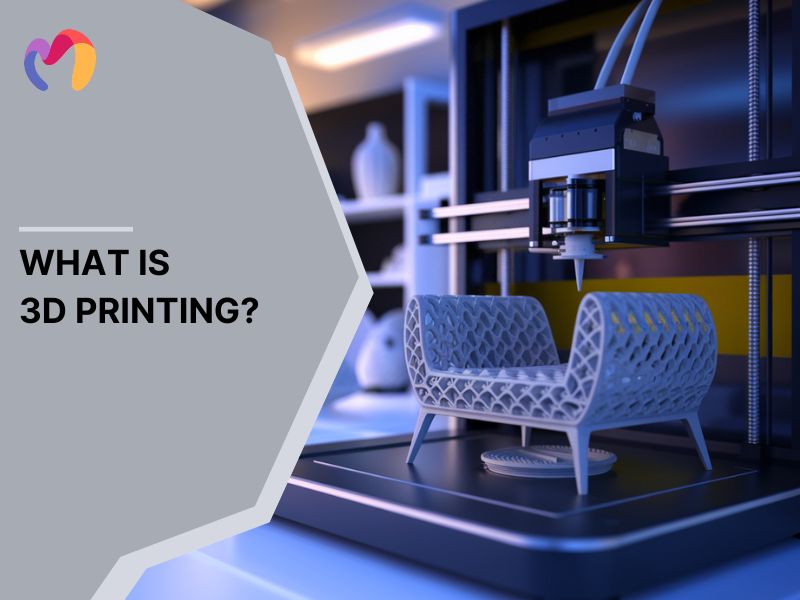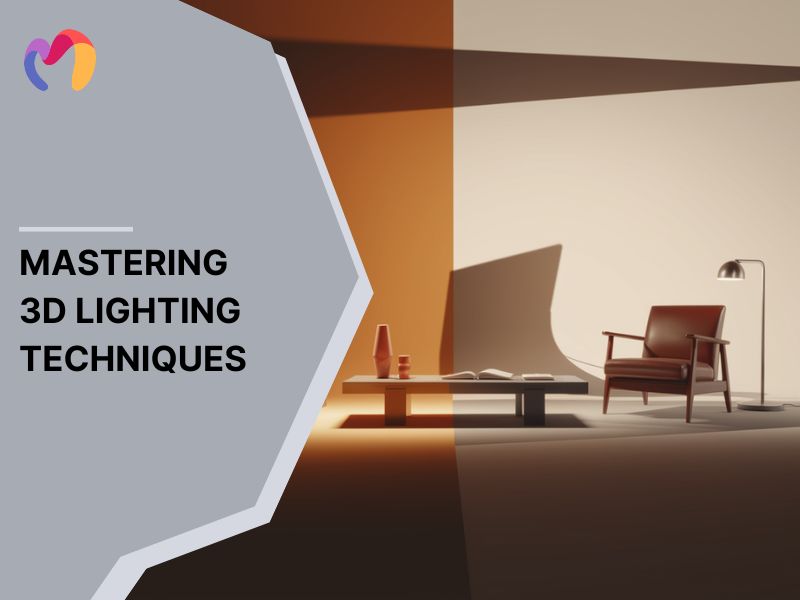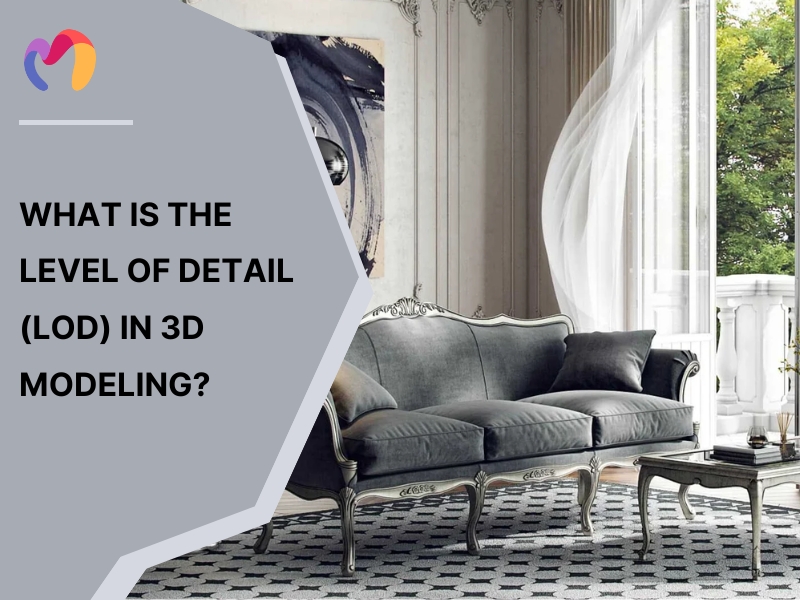What Is 3D Texturing? A Comprehensive Guide to Enhancing 3D Models
3D texturing is the process of adding textures to 3D objects to enhance realism and visual appeal. It transforms basic 3D models into vibrant objects and environments through the application of colors, patterns, and material properties.
In this article, we provide a comprehensive overview of the 3D texturing pipeline, covering core techniques, texture set management, complex geometry handling, and industry best practices. We particularly focus on performance optimization and maintaining texture style consistency, key concerns for professional 3D artists.
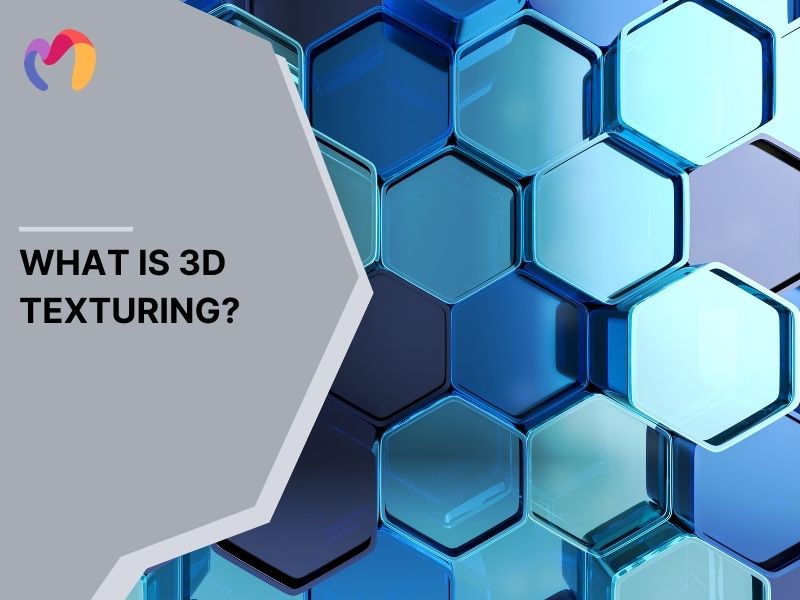
1. What is 3D Texturing?
3D texturing plays a pivotal role in creating realistic and visually engaging digital models. The following sections explore what 3D texturing is and its applications across various industries.
1.1 Definition
3D texturing is the method of adding surface texture details to 3D models. It involves mapping colors, patterns, and material attributes onto a model’s surface to replicate real-world materials. Architects or designers use textures to mimic properties such as the sheen of metal or the rough texture of stone, creating realistic digital assets for various applications.
1.2 The Importance of 3D Texturing Across Industries
3D texturing has revolutionized numerous industries by enabling the creation of photorealistic digital assets and immersive experiences. Its versatility and practical applications have made it an essential tool across various professional fields.
- Architecture and Real Estate: In architecture and real estate, 3D texturing transforms conceptual designs into vivid presentations. Architects and designers leverage texturing to create accurate material representations, from the warmth of wooden floors to the sleek finish of modern metal facades.
- Gaming and Entertainment: The gaming and entertainment industry relies heavily on 3D texturing to create compelling virtual worlds. Game developers use advanced texturing techniques to make a 3D model look more realistic, enhancing character designs, environmental elements, and interactive objects. This attention to detail helps maintain visual consistency across different gaming platforms while optimizing performance and user experience.
- Film and Animation: In film and animation, 3D texturing is fundamental to creating believable digital characters and environments. Studios utilize high-resolution textures to ensure assets appear realistic in both wide shots and extreme close-ups. This versatility allows for efficient asset reuse across multiple projects while maintaining visual quality.
- Product Design: Product design benefits significantly from 3D texturing capabilities. Manufacturers can create detailed digital prototypes with accurate material properties, significantly reducing the need for physical samples. This approach accelerates the design process and facilitates more effective collaboration between teams, leading to faster product development cycles.
- Medical Visualization: Medical visualization has embraced 3D texturing for creating detailed anatomical models. These textured models provide medical professionals with accurate representations for surgical planning and training. The technology enables clear communication with patients through realistic visual aids, improving understanding of medical procedures and conditions.
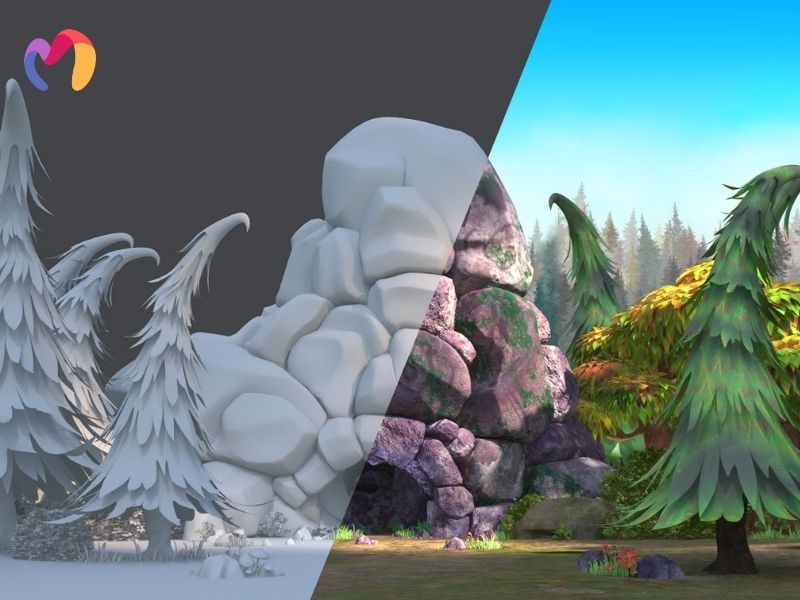
2. What Are 3D Texturing Techniques?
3D texturing involves various methods to create and apply surface details to 3D models, enhancing their realism and visual appeal. Below are the key techniques used in the process:
- Painting: Digital texture painting lets artists apply textures directly onto 3D models with precision. This method gives creators full control over texture placement and enables crafting unique, non-repetitive designs. It’s ideal for intricate patterns and customized artistic elements.
- Procedural Texturing: Procedural texturing uses algorithms to generate textures programmatically. It is effective for creating seamless, repeatable patterns and simulating natural surfaces like wood, stone, or metal. This technique allows infinite variations without manual adjustments.
- PBR Texturing: Physically Based Rendering (PBR) focuses on realistic material creation by simulating physical properties. It ensures materials appear consistent under various lighting and environmental conditions, making it standard for modern rendering pipelines.
- Photogrammetry: Photogrammetry transforms photos of real-world objects into digital textures. This technique captures high-detail surfaces and creates photorealistic materials, providing a reliable way to replicate real-life appearances in virtual environments.
- Sculpting: Digital sculpting adds detailed surface features directly onto 3D models. It is indispensable for creating organic details, such as skin pores, fabric folds, or surface irregularities, making it a preferred method in character and environment design.
- UV Mapping: UV mapping unrolls 3D surfaces into a flat 2D space, enabling accurate texture alignment. This technique ensures textures fit correctly on models, avoiding distortion and misalignment. It is essential for high-quality 3D texturing workflows.
>> See more: Comprehensive Guide in The 3D Modeling Workflow
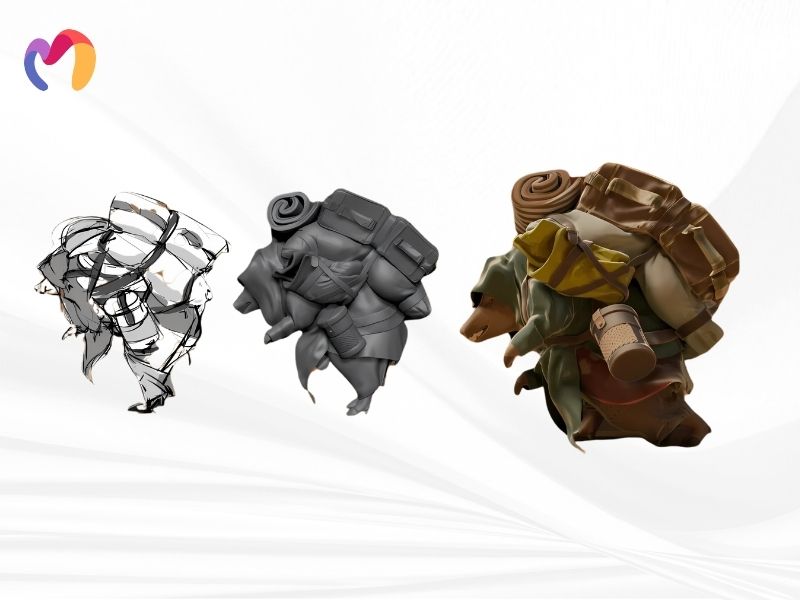

3. Different Types of Texture Mapping
3D texturing involves diverse mapping techniques to create realistic and functional surfaces. Each type plays a distinct role in achieving accurate visual effects:
- Color Maps (Diffuse/Albedo): Color maps define the primary hues and patterns of a surface. Diffuse maps include basic shadow details, while albedo maps focus on pure surface colors, excluding any light or shadow information. Albedo maps are essential for physically-based rendering (PBR), ensuring consistent results under varied lighting.
- Normal Maps: Normal maps simulate surface details, such as bumps and grooves, without altering geometry. By modifying light interaction, they enhance detail while keeping models lightweight for performance-critical applications. This technique is widely used for adding intricate textures like fabric weaves or stone cracks.
- Roughness Maps: Roughness maps use grayscale values to control light diffusion. Dark regions denote smooth, reflective surfaces, while lighter areas show rough, scattered light effects. These maps are vital for replicating the visual texture of materials such as polished metal or coarse wood.
- Metallic Maps: Metallic maps distinguish between metallic and non-metallic regions on a surface. They use binary values—typically black for non-metal and white for metal—to control reflectivity and conductivity. Metallic maps contribute to realistic material behavior in PBR workflows.
- Displacement Maps: Displacement maps modify a model’s geometry to create actual surface variations, such as cracks or raised patterns. Unlike normal maps, they physically deform the mesh, making them indispensable for close-ups or high-resolution renders.
- Specular Maps: Specular maps define the brightness and color of highlights on a surface. They control how reflective specific areas are, making them crucial for creating materials like glossy plastic or polished stone.
>> See more: What Is A Polygon in 3D Modeling? Compare High-Poly Vs Low-Poly Ones
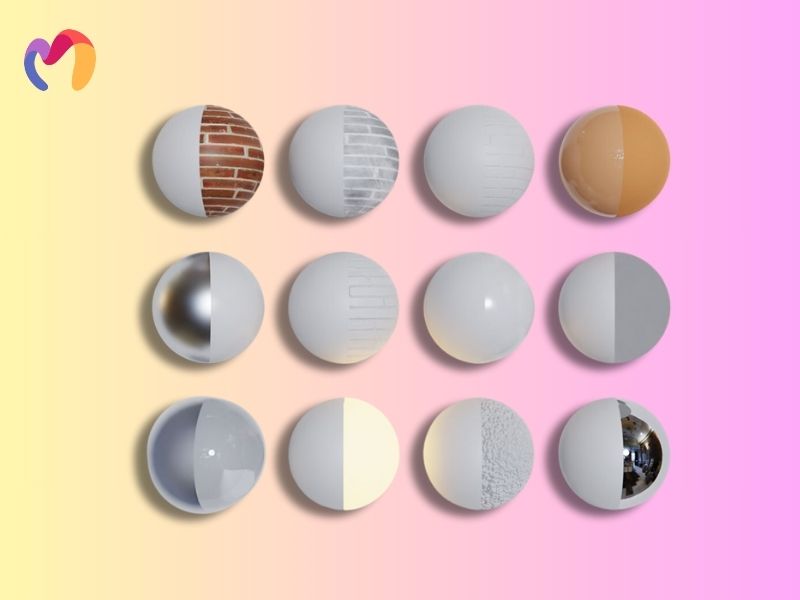

4. The 3D Texturing Process
Creating high-quality 3D textures involves a structured workflow essential for achieving realistic visual results.
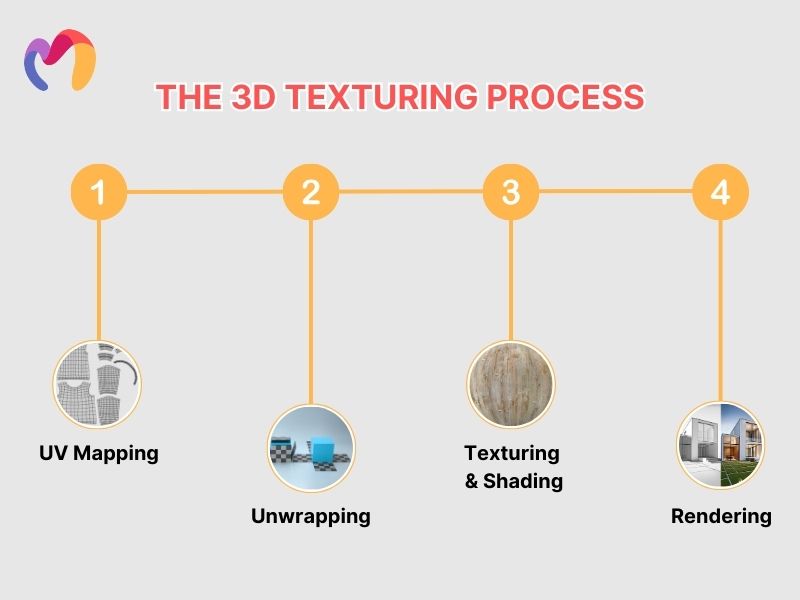

- UV Mapping: The process begins with UV mapping, where 3D models are flattened into 2D coordinate systems. This step sets the stage for precise texture placement and minimizes distortions in the mapping process.
- Unwrapping: Artists define seams and adjust UV island layouts during unwrapping. This approach optimizes texture space usage, reduces waste, and ensures seamless integration of textures across model surfaces.
- Texturing and Shading process: This phase applies texture maps and establishes material properties. Techniques like procedural generation or hand-painting create base colors, surface patterns, and material finishes. Artists assign shaders to enhance realism by simulating properties like gloss, roughness, or transparency.
- Rendering: In the final step, rendering calculates how light interacts with textures. This reveals the model’s appearance under different lighting setups, providing a polished visual output ready for integration into scenes or projects.
>>> See more: What Is 3D Rendering? A Comprehensive Guide to Digital Image Creation
5. Essential Tools and Software for 3D Texturing
Creating a realistic 3D model in the texturing requires specialized tools and software tailored to different stages of the process. Below is a categorized list of essential tools and their roles in 3D texturing.
1. Texture Creation and Painting
To design and customize textures, these tools are indispensable:
- Substance Painter: A powerful software for painting detailed and realistic textures directly onto 3D models with ease. It offers real-time rendering capabilities and an extensive library of materials and brushes.
- Adobe Photoshop: Ideal for creating 2D textures, manipulating images, and layering effects to build unique textures. Its advanced editing features make it essential for texture artists.
- Quixel Mixer: Combines procedural texturing with a vast library of ready-made materials for seamless texture creation. Perfect for environmental and architectural texturing.
2. UV Mapping and Preparation
UV mapping is crucial for unwrapping 3D models and preparing them for texture application. Key tools include:
- Blender: An open-source tool with robust UV mapping features for unwrapping and editing UV layouts. Its comprehensive toolset supports both basic and advanced UV mapping needs.
- Maya: Offers advanced UV tools for precision unwrapping and seamless integration with other design workflows. Particularly strong in handling complex geometry.
- RizomUV: Specializes in automated UV unwrapping and optimization, significantly speeding up the preparation process.
3. Surface Detail Enhancement
For creating intricate surface details, these tools are essential:
- ZBrush: Industry-standard software for digital sculpting and creating high-resolution surface details. Excels at organic texturing and fine detail work.
- Mudbox: Provides intuitive sculpting tools for adding surface details and creating displacement maps. Perfect for character and environmental texturing.
4. Texture Map Generation
These tools specialize in creating various types of texture maps:
- Substance Designer: Excels at creating procedural materials and generating texture maps. Offers powerful node-based workflow for material creation.
- xNormal: Efficiently handles the baking of normal maps and other texture maps. Known for its speed and accuracy.
- Marmoset Toolbag: Combines map baking capabilities with real-time rendering for immediate feedback.
5. Rendering and Preview
For testing and finalizing textures:
- Arnold Renderer: Professional-grade rendering engine that integrates with major 3D applications. Delivers photorealistic results.
- Unreal Engine: Provides real-time rendering and testing capabilities. Essential for game development and interactive visualization.
6. Asset Management
For organizing and managing texture resources:
- Autodesk Vault: Comprehensive digital asset management system for version control and file organization.
- Substance Source: Extensive library of high-quality materials and textures. Streamlines the texture creation process.
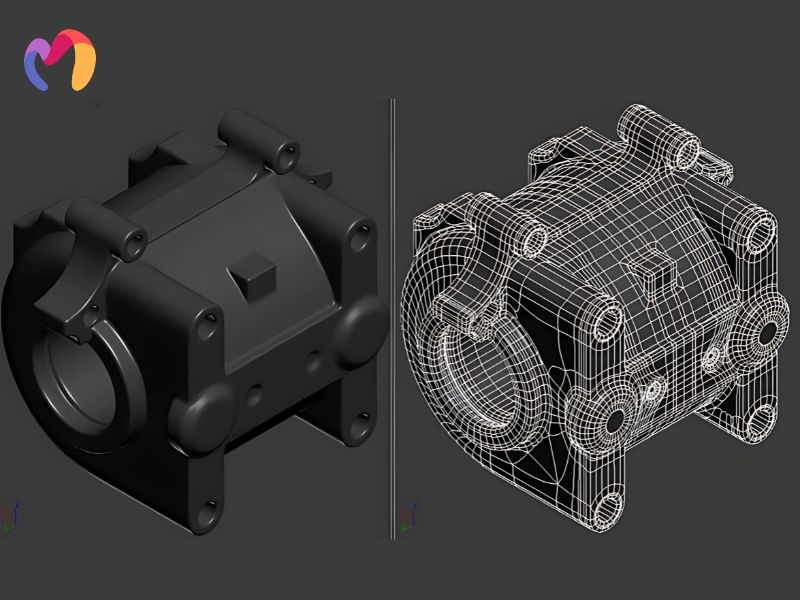

6. Frequently Asked Questions
What is the difference between 3D modeling and 3D texturing?
3D modeling defines the shape and structure of objects, forming their geometric framework. 3D texturing applies surface details like color, patterns, and material attributes, making models visually realistic. Both are essential for producing polished 3D assets.
What are the primary types of textures used in 3D design?
Textures are categorized into tiling and unique types.
- Tiling textures repeat seamlessly, covering large surfaces efficiently, such as walls or floors.
- Unique textures are crafted for specific models, offering tailored details but less reusability.
How long does 3D texturing take?
Time depends on the model’s complexity and required detail.
- Simple objects: 2–8 hours
- Complex characters/environments: 40–80+ hours
7. Conclusion
3D texturing plays a pivotal role in elevating the quality and authenticity of 3D models. From implementing fundamental techniques like UV mapping to advanced methods such as PBR and procedural texturing, each step in the process demands precision and expertise. Mastering the 3D software tools, understanding light interaction, and efficient texture set management are crucial for creating high-quality 3D outputs.
To explore more advanced texturing techniques and stay updated with the latest industry trends, visit our blog. We regularly share in-depth articles about UV mapping, procedural texturing, and tips for optimizing your 3D texturing workflow.
3DMAXTER LTD
- Email: [email protected]
- Phone: +1 (929) 450-2898
- Address: 95-38 Queens Blvd, Rego Park, NY 11374, USA
Thank you for choosing 3DMAXTER LTD.
